#Franzerhardwalther
Photo

Work Drawing: 10 x Place Distance Place, Franz Erhard Walther, 1968-74, MoMA: Drawings and Prints
Richard S. Zeisler Bequest (by exchange)
Size: 11 5/8 x 8 1/4" (29.5 x 21 cm)
Medium: Watercolor, ink, and pencil on paper
http://www.moma.org/collection/works/162325
146 notes
·
View notes
Photo



ERHARD WALTHER, FRANZ( Alemania, 1939)
Su obra se ha ido desarrollando desde la década de los 50 hasta hoy en día. Trabaja practicamente todas las ramas,el performance y la escultura sobretodo. Pero también trabaja la fotografía y el collage, la pintura y el dibujo. Se le incluye entre los artistas del post minimalismo y el land art. Es un arte que no pretende ser meramente observado o contemplado si no que busca la interacción con el espectador, que de esta forma se convierte en más que eso y vive la obra como una experiencia de los sentidos. Su obra nos presenta una serie de preguntas que nos llevan a la reflexión de cómo vivimos, cómo ocupamos el espacio que nos rodea y dejamos pasar el tiempo mientras que vivimos.
#franz erhard walther#franz#franz erhard#franzerhard#franzerhardwalther#Alemania#germany#performance#escultura#sculpture#fotografia#photography#collage#pintura#painting#dibujo#drawing#minimalismo#minimalism#postminimalismo#post minimalismo#landart#land art#instalación#installation
1 note
·
View note
Photo

#FranzErhardWalther https://www.instagram.com/p/CDG9m--og--/?igshid=1oipdzt7nbayz
3 notes
·
View notes
Photo

“The #Body Added” by #FranzErhardWalther More info at: https://barbarapicci.com/2022/04/20/the-body-added-by-franz-erhard-walther/ #WallFormationSeries #bodyart #artinstallation #installazione #installation #installationview #exhibitionview #conceptualart #cultureisfreedom #artisfreedom #curiositykilledtheblogger #artblogging #photooftheday #artaddict #artistsoninstagram #artwork #instacool #instaart #followart #artlover #contemporaryart #artecontemporanea #artmuseum #artcurator #artwatchers #artcollectors #artdealer #arthistory https://www.instagram.com/p/CckfqGlIAbs/?igshid=NGJjMDIxMWI=
#body#franzerhardwalther#wallformationseries#bodyart#artinstallation#installazione#installation#installationview#exhibitionview#conceptualart#cultureisfreedom#artisfreedom#curiositykilledtheblogger#artblogging#photooftheday#artaddict#artistsoninstagram#artwork#instacool#instaart#followart#artlover#contemporaryart#artecontemporanea#artmuseum#artcurator#artwatchers#artcollectors#artdealer#arthistory
1 note
·
View note
Photo
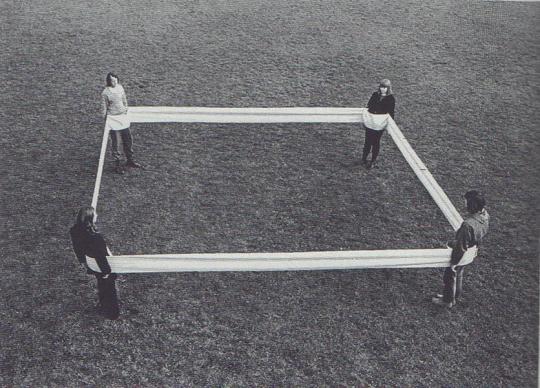
Franz Erhard Walter, 1968
0 notes
Photo
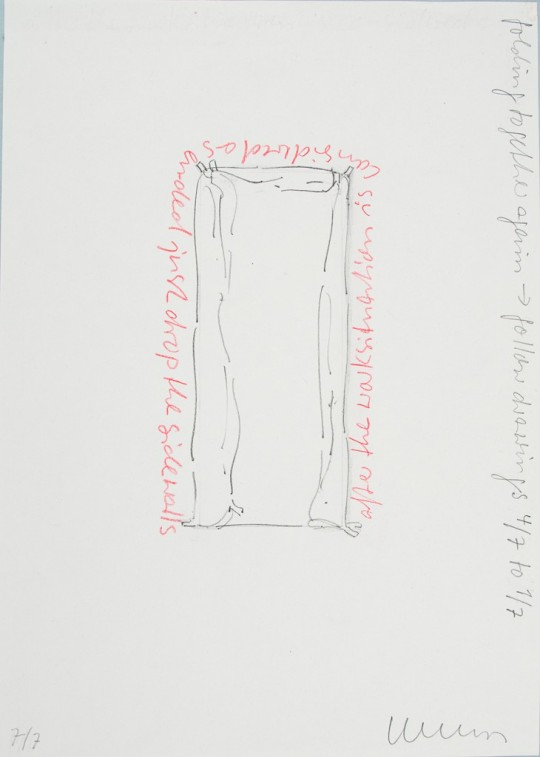
Illustrated Instructions for First Workset, Number 26: Head Body Limbs, Franz Erhard Walther, 2004, Harvard Art Museums: Drawings
Nine pages of illustrated instructions for handling and use of the object Head Body Limbs. Harvard Art Museums/Busch-Reisinger Museum, Gift of the artist © Franz Erhard Walther / Artists Rights Society (ARS), New York, NY
Size: 29.7 x 21 cm (11 11/16 x 8 1/4 in.)
Medium: Graphite on white wove paper
https://www.harvardartmuseums.org/collections/object/5190
0 notes
Text
On the Spatiality of Time, Linear and Rectilinear
Magda Wisniowska’s thoughts on the exhibition of Franz Erhard Walther’s work at Haus der Kunst – Munich, November, 2020.
With its sombre form and dull grey fabric “Song of the Walking Pedestals” (1975-77), is not perhaps the most eye-catching of Franz Erhard Walther’s works, and that is also perhaps why it is confined to one long, corridor-like room at the back of the Haus der Kunst’s major retrospective of the artist. As the museum label helpfully explains, it consists of three elements. There is the physical object, in four parts, with each part divided into two along a central axis. Each of these divided sections consists of six to eight wooden, cotton-covered rectangular components, box or tray-like in shape, with one or two sides missing. These components are stacked one on top of another, lined up to open outwards, the full sides slotting neatly into the corner. The top tray is small and can be picked up comfortably; the one lowest down is more than four metres in length. Together they form a series of low lying, irregular steps, their rhythm occasionally interrupted by a tray which has three sides instead of two. Then, there is the second element, the viewer or rather in this case, the participant, who walks up and down these objects, perhaps pausing at each end. As the panel states, by walking along the path dictated by the object, our activity completes the work, the object “becomes a pedestal, and the body, the sculpture.” Finally, there is element number three, the architectural setting: the long windowless room with its high ceiling and modest light; the stone tiled floor, almost exactly the same colour as the cotton fabric.
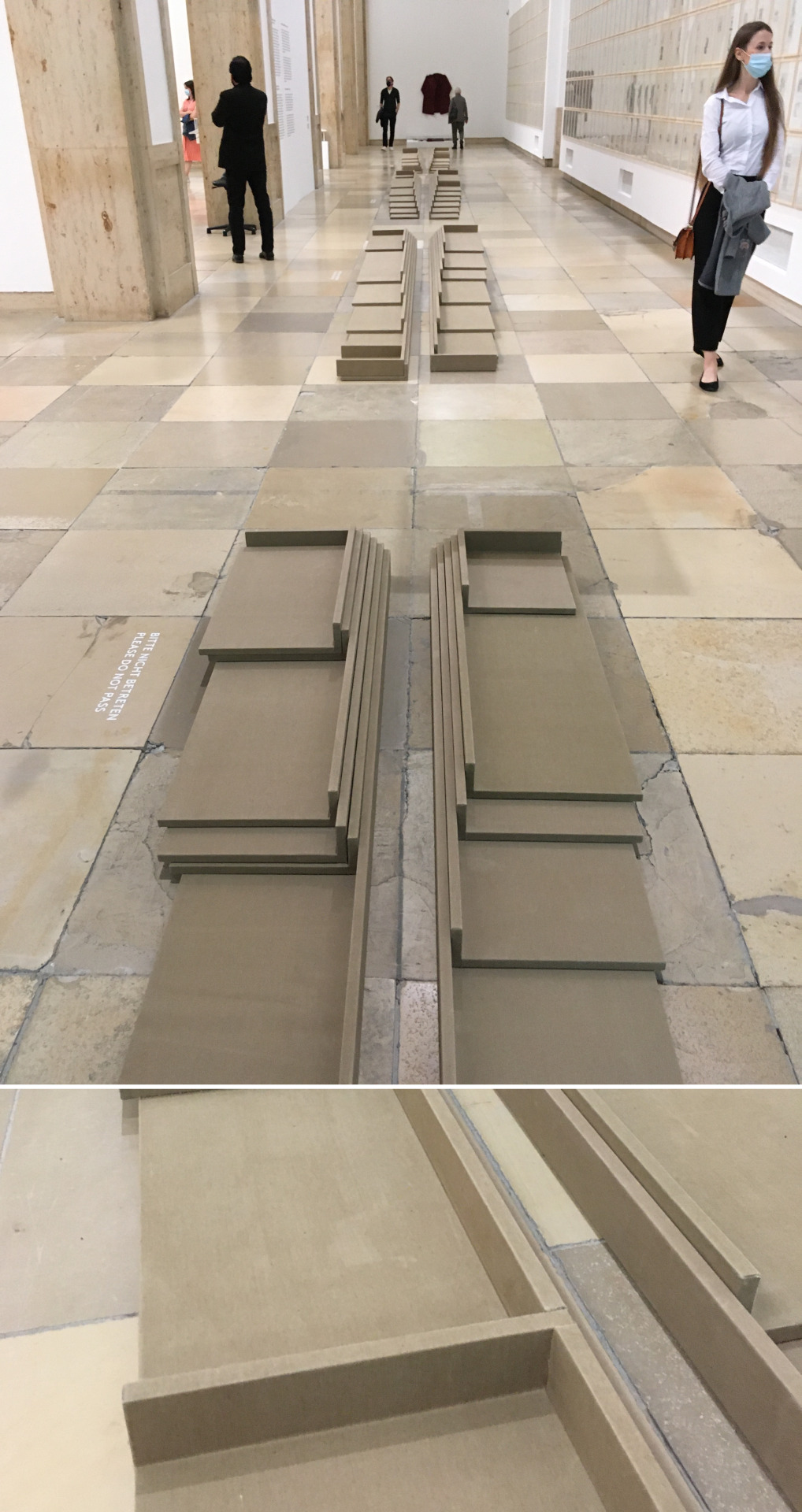
[Installation view and close-up of Franz Erhard Walther's 'Song of the Walking Pedestals' (1975-77) at Haus der Kunst, Munich, 2020; Image credits: the author]
Again, as the panel states, the work is deemed significant because of the way it expands the “traditional understanding of sculpture” by “elevating the body, space, and time to its material.” Space, understood here as the space occupied by the work, is defined by the movement of our body, which occurs in time. All three — space, body, and time —become the material of the work. These concepts of the body, space, and time recur throughout the exhibition; they are key terms in the artist’s practice.

[Information panel to Franz Erhard Walther's 'Song of the Walking Pedestals' (1975-77), as installed at Haus der Kunst, Munich, 2020; Image credits: the author]
Standing in this long room, never able to see the entirety of the work except from each end, it occurred to me, that these concepts — the body, space, time — as they are presented here, are framed in a very Kantian manner. Kant takes his cue from Isaac Newton and it is true that the work has a Newtonian character. Space is distinct from the body — as is time, passing with the uniformity of a well sprung pocket watch. The motion of a body occurs through space and in time, its path mapped along two key axes, coordinates charting its speeds, pauses, and moments of acceleration. Walking up and down the work, we can draw a line of our movements, our body reduced to point A or B or C, progressing across the grid of the tiled floor.
Out of the three concepts, especially the concept of time has a prominent part to play. I do not think it is a coincidence that the wall piece above “Song of the Walking Pedestals” is “Dust of Stars. A Drawn Novel” (2007-2009) in which Walther documents the development of his oeuvre with individually framed drawings of key moments in his life, all 524 of them. In “Song of the Walking Pedestals” time acquires a physicality, a spatial dimension. If the text of the institutional panel suggests that it is the movement of our body that defines the space of the work, I want to counter that it only does so because it already posits a spatial concept of time. This has to do with what Gilles Deleuze calls Kant’s “great reversal,” in which time stops being related to the movement it measures and instead conditions this movement, as it does all bodies, because it conditions our perception of them. Deleuze writes,
…movement is no longer the determination of objects, but the description of a space, a space we must set aside in order to discover time as the condition of action. Time thus becomes unilinear and rectilinear, no longer in the sense that it would measure a derived movement, but in and through itself, insofar as it imposes the succession of its determination on every possible movement. This is a rectification of time. (“On Four Formulas” in Essays Critical and Clinical, 28)
Deleuze describes Kantian time as a condition of action, derived from a movement which is no more than a description of space. Time is unilinear, a line; this line is straight, rectilinear. Rectification here refers to the activity of straightening.
Space and time are two important concepts in Kant, defined as the two forms of pure intuition that allow for the syntheses of knowledge. The form of space belongs to our outer sense, the way in which we present objects as outside of us. In space, their shape, size, and relation to one another can be determined. Time is the form of inner sense, the way in which our mind presents thoughts to itself as occurring in a sequence. Neither space nor time is a property of the outside world — things for Kant are not inherently spatial and it would follow that for Kant not all thoughts are time-based — but together they are necessary for how this world is perceived by us. The world appears to us in space and in time.
The question I have at this point is of the relation between the two, that which Deleuze describes as the “setting aside of space” to “discover time as the condition of action.” Whatever determination of outer sense we might make, this is a determination, which is made in the mind, one which involves the activity of the mind in order to be made. Hence all appearances occur not just in space but also in time. From this, it would seem that time casts its character, stamps its mould if you will, over all spatial determinations. Yet it is not so, as Kant takes care to point out in a note to his Preface (B xl) in which he requests a passage change to further elaboration of this issue in the discussion of synthetic principles in the Transcendental Logic (B 275). In both places, Kant presents the consciousness of our existence in time as linked to the consciousness of a relation to something outside of ourselves. There is a link between how we experience our own thoughts and how we experience the outside world. We experience our inner thoughts externally, in the same way we experience any other object to which we relate. Kant goes a step further, to argue that this is the very definition of inner sense, this ability to have this distance of an indirect relation to one’s own thinking, to experience what is inner as an outer. Kant wants to prove that our inner experience, so indubitable for Descartes, is only possible by presuming an outer experience.
With inner sense being only possible through having an outer sense, it is not surprising that in Kant the form of time acquires the taint of geometry. If we perceive the world spatially, as a series of objects and their relations within a given space, we experience thinking, as it occurs in time, in much the same way. As Deleuze would say, this is why time in Kantian philosophy acquires this unilinear and rectilinear character: it becomes an axis, a straight line. For Walther too, the passage of time takes this linear shape, especially visible in a piece like “Dust of Stars,” where the development of the work is reduced to single ordinal points, each enclosed by an identical rectangular frame.
This pervasive aspect of geometry was also my impression of the exhibition and specifically this piece, “Song of the Walking Pedestals.” I would argue that it too involved a spatial concept of time, in which the sense of time relates to the sense of space. Yes, we define a space with our movements as we experience the object, becoming as it were, the sculpture, and the object, our pedestal. But we can experience the object in this specific way because the work already makes certain assumptions. Through its insistence on the line, on right angles, on those series of progressive, upward steps, it puts us in the position of a body that is defined through its capacity of perceiving the world only through these spatial relations. I have likened the components of the piece to open ended trays, to give the sense that these are to present us, the viewer, as the active participant of the work. But maybe they are more like the lids of open boxes, ready to enclose us and diminish us to a single point on an axis.
Walther’s work, “Song of the Walking Pedestal” calls us to expand our notions of sculpture. As the museum panel states, no longer is sculpture to consist of a mere three-dimensional object placed on a pedestal, but is now to incorporate the viewer as an active participant. The work is the viewer’s body, his movement, his definition of architectural space. What was previously unseen, in this work gains a materiality. But if the work expands our notions of sculpture, it does so in quite a narrow way. For the materiality it espouses is already mathematically determined: space is a matter of shape, size, relation; time is experienced in the same way as space; movement becomes subordinated to the two and no more than a description of space; and the body, this is caught up in the various lines the work has drawn, to become a mere a point of relation.
#magdawisniowska#meta review#franzerhardwalther#hausderkunst#definitionofspacethroughthebody#sculpture#deleuze#kant#space#time#movement#formsofintuition
0 notes
Photo

Franz Erhard Walther, Kreuz Bewegungsraum, 1967 #franzerhardwalther #performance https://www.instagram.com/p/B-vCxuCpYGG/?igshid=xxhkh29mwwz6
0 notes
Photo



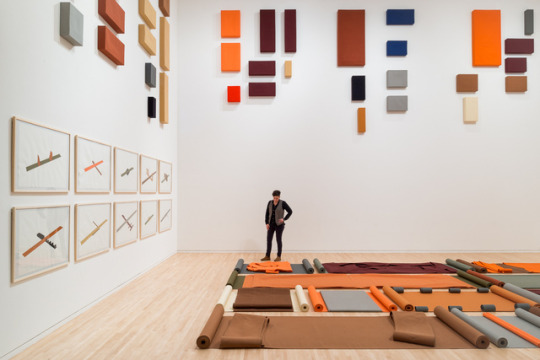
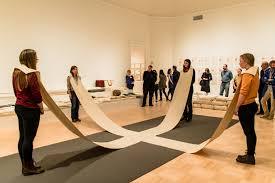




Studio Project in 3 parts
Our studio project for the semester is inspired by the layered concept of a puppet show. Like with a puppet show, I want you to consider how multiple built components (such as the way a puppet and a stage set up) can work together to create a meaningful space for an performative event or activation to occur. Taking advantage of some of the new skills, materials, processes and techniques we are learning in class, I want you to apply fiber sculpture to your art practice and create an experience that is performative or activated in some way.
I’ve found fiber structures and concepts, materials, and processes to be uniquely positioned to offer meaningful advantages to making multifaceted and thoughtful experiences for contemporary artists and consider this studio project a chance to explore what this might look like in your own work.
We will discuss your cumulative fiber sculpture studio projects 3 times, with each critique building on the last, culminating in a final critique at the end of the semester with your multifaceted projects activated or performed.
The objectives for the studio project are:
1.) To create a structure for you to continue to pursue your own art practice and individual voice through the creation of a sophisticated thoughtful artwork.
2.) To apply fiber processes, techniques and ideas in an authentic way to your art making.
3.) To understand better what fiber sculpture is and what it has to offer contemporary art.
4.) To provide the means for you to have the time necessary to create a layered artwork with multiple elements that work together to offer a meaningful experience to a viewer.
5.) To explore how an artwork can be activated through art methodologies of performance, time based strategies, mixed media approaches, installation strategies, collaboration or participation.
6.) To continue to cultivate your abilities and point of view in all aspects of an artist’s studio production: from concept to design, sourcing materials, from production to presentation, artwork documentation and further description in supplement written materials like titles and statements...etc.
Critique dates….
Part 1: October 16, October 18
Part 2: November 8, November 13
Part 3: December 4, December 6, December 11
Images from top:
First image is of the Superclogger Project by Los Angeles based artist Joel Kyack. Watch a video of a panel discussion with the artist and curators of the project here.
The next two images are of a multifacted project by Los Angeles based artist Katie Grinnan called Rubble Division (watch artist video of the project here and read more specifically about the project.) The first image is of the costumes the artist made for her musicians to wear performing in the project and the second is an image of the project in its final form, as exhibited in Interstate: The American Road Trip, curated by Alyson Baker and Andrea Zittel.
The next two images are of work by artist Franz Erhard Walther. These show two views of his work, the first as displayed in the gallery, and the second activated through performance periodically scheduled throughout the run of the gallery exhibition the work is on view. Watch his work being performed in this linked video.
The next two images show different iterations of the Suffragette City project by artist Lara Schnitger. The first image shows the work as displayed in a gallery context. The second image shows the work activated in a performance on the street. Here is a video of one such performance.
The final two images of Puerto Rico collaborative artist duo known as Poncili Creacion. The first image is a storyboard style sketch detailing typically how they prepare a narrative structure for one of their performances. The second image is from a 2016 performance in New York City. Here is an article about the work and a link to a video of part of a performance.
2 notes
·
View notes
Photo

*Instameet @igersvienna * The Canaletto View is an Art Project initiated by @erstebank.sparkasse at their Headquarter the so called "Erste Campus". Curated by Kathrin Rhomberg and Pierre Bal-Blanc. Thanks for this guided Tour! Here are some Artpieces. Swipe 👉 * 1 Lois Weinberger: Wooden Cottage with greenery composting inside. * 2 Clemens von Wedemeyer: Movie "Esiod 2015". * 3 Slaven Tolj: Soundinstallion "From Ten to Zero", behind the Wall. * 4 Olga Chernysheca: Charcoal Drawings. * 5 Franz Erhard Walther: 19 Artpieces . . #erstestiftung #erstecampus #erstebank #igersvienna #LoisWeinberger #ClemensVonWedemeyer #SlavenTolj #OlgaChernysheva #FranzErhardWalther #henkeschreieck #KathrinRhomberg #PierreBalBlanc #artinvienna #igersaustria #collectmomentsnotthings #visualstoryteller #artsyvisualstorytelling #artsycontentcreator #artblogger #neverstopexploring #discoveraustria #minimalmag #archi_focus_on #archidaily #ig_ometry #jj_geometry #m_inimal #viennanow #stadtwien #fromwhereistand (at Erste Campus Wien) https://www.instagram.com/p/BuO7MY1BfzE/?utm_source=ig_tumblr_share&igshid=14jkxu7qwqibw
#erstestiftung#erstecampus#erstebank#igersvienna#loisweinberger#clemensvonwedemeyer#slaventolj#olgachernysheva#franzerhardwalther#henkeschreieck#kathrinrhomberg#pierrebalblanc#artinvienna#igersaustria#collectmomentsnotthings#visualstoryteller#artsyvisualstorytelling#artsycontentcreator#artblogger#neverstopexploring#discoveraustria#minimalmag#archi_focus_on#archidaily#ig_ometry#jj_geometry#m_inimal#viennanow#stadtwien#fromwhereistand
0 notes
Photo

BACK IN THE BOOKSHOP: FRANZ ERHARD WALTHER "First Work Set" (2016) Comprising 58 fabric elements – what the artist has termed ‘instruments for process’ – this multi-part sculpture, began in 1963 in Düsseldorf and was completed in 1969 in New York City, is Walther’s most ambitious work. This publication retraces Walther’s use of malleable materials and ephemeral ‘actions’ as the basis for his sculptures, his understanding of the role of language, and the presence of drawing as integral to his conception of space. As with Walther’s similar works, First Work Set’s individual fabric elements are activated by visitors in a series of quotidian actions such as folding, dropping, leaning and measuring, that often entail cooperation among a couple or a group. For decades, museum exhibitions of this work have placed folded archival versions of the fabric elements in vitrines, preventing viewers from receiving the direct, performative encounter originally intended by the artist. For this exhibition at Dia:Beacon, Dia worked collaboratively with Walther to select a number of the original fabric elements available to be directly handled and performed by visitors. During the exhibition, Dia held an event inviting leading scholars to take advantage of the opportunity to experience the work firsthand in this way, and to present new thinking on his oeuvre. This book is a unique project grown out of the inclusion of this major work in Dia’s collection in the exhibition Franz Erhard Walther: Work as Action, presented at Dia:Beacon, New York, 2 October 2010 – 15 February 2012. Available via our website and in the bookshop. #worldfoodbooks #franzerhardwalther (at WORLD FOOD BOOKS)
1 note
·
View note
Photo

Work Drawing: 10 x Place Distance Place, Franz Erhard Walther, 1968-74, MoMA: Drawings and Prints
Richard S. Zeisler Bequest (by exchange)
Size: 11 5/8 x 8 1/4" (29.5 x 21 cm)
Medium: Watercolor, ink, and pencil on paper
http://www.moma.org/collection/works/162320
19 notes
·
View notes
Video
Sehkanal (Channel of Sight), 1968. Franz Erhard Walther.
0 notes
Photo

Wearing your black sweater to feel you close to me #FranzErhardWalther
3 notes
·
View notes
Photo

“Element No. 5: Elfmeterbahn” by #FranzErhardWalther @ #KunsthalleDüsseldorf, 1969 More info at: https://barbarapicci.com/2022/03/28/element-no-5-elfmeterbahn-by-franz-erhard-walther/ #bodyart #biancoenero #blackandwhite #performaceart #installationview #exhibitionview #cultureisfreedom #artisfreedom #curiositykilledtheblogger #artblogging #photooftheday #artaddict #artistsoninstagram #amazing #artwork #instacool #instaart #followart #artlover #modernart #artemoderna #artmuseum #artcurator #artwatchers #artcollectors #artdealer #arthistory https://www.instagram.com/p/CbqK3XaAfsQ/?utm_medium=tumblr
#franzerhardwalther#kunsthalledüsseldorf#bodyart#biancoenero#blackandwhite#performaceart#installationview#exhibitionview#cultureisfreedom#artisfreedom#curiositykilledtheblogger#artblogging#photooftheday#artaddict#artistsoninstagram#amazing#artwork#instacool#instaart#followart#artlover#modernart#artemoderna#artmuseum#artcurator#artwatchers#artcollectors#artdealer#arthistory
0 notes
Photo
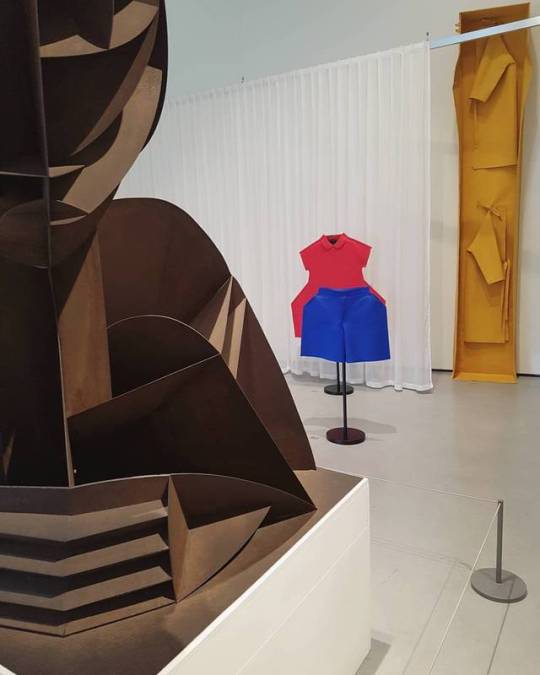
#jwanderson #naumgabo #franzerhardwalther #disobedientbodies #hepworthwakefield #hepworthgallery #thehepworth (at The Hepworth Wakefield)
#thehepworth#franzerhardwalther#hepworthgallery#naumgabo#jwanderson#hepworthwakefield#disobedientbodies#personal
1 note
·
View note